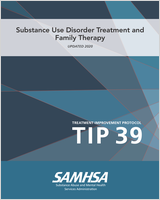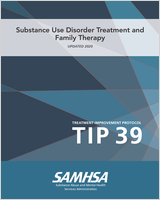NCBI Bookshelf. A service of the National Library of Medicine, National Institutes of Health.
Center for Substance Abuse Treatment. Substance Abuse Treatment and Family Therapy. Rockville (MD): Substance Abuse and Mental Health Services Administration (US); 2004. (Treatment Improvement Protocol (TIP) Series, No. 39.)
This publication is provided for historical reference only and the information may be out of date.
Treatment Improvement Protocols (TIPs), developed by the Center for Substance Abuse Treatment (CSAT), part of the Substance Abuse and Mental Health Services Administration (SAMHSA) within the U.S. Department of Health and Human Services (DHHS), are best‐practice guidelines for the treatment of substance use disorders. CSAT draws on the experience and knowledge of clinical, research, and administrative experts to produce the TIPs, which are distributed to a growing number of facilities and individuals across the country. The audience for the TIPs is expanding beyond public and private treatment facilities as alcohol and other drug disorders are increasingly recognized as a major problem.
CSAT’s Knowledge Application Program (KAP) Expert Panel, a distinguished group of experts on substance use disorders and professionals in such related fields as primary care, mental health, and social services, works with the State alcohol and drug abuse directors to generate topics for the TIPs. Topics are based on the field’s current needs for information and guidance.
After selecting a topic, CSAT invites staff from pertinent Federal agencies and national organizations to a Resource Panel that recommends specific areas of focus as well as resources that should be considered in developing the content for the TIP. Then recommendations are communicated to a Consensus Panel composed of experts on the topic who have been nominated by their peers. This Panel participates in a series of discussions; the information and recommendations on which they reach consensus form the foundation of the TIP. The members of each Consensus Panel represent substance abuse treatment programs, hospitals, community health centers, counseling programs, criminal justice and child welfare agencies, and private practitioners. A Panel Chair (or Co‐Chairs) ensures that the guidelines mirror the results of the group’s collaboration.
A large and diverse group of experts closely reviews the draft document. Once the changes recommended by the field reviewers have been incorporated, the TIP is prepared for publication, in print and online. The TIPs can be accessed via the Internet at the URL:www.csat.samhsa.gov. The move to electronic media also means that the TIPs can be updated more easily so that they continue to provide the field with state‐of‐the‐art information.
While each TIP strives to include an evidence base for the practices it recommends, CSAT recognizes that the field of substance abuse treatment is evolving, and research frequently lags behind the innovations pioneered in the field. A major goal of each TIP is to convey “front‐line” information quickly but responsibly. For this reason, recommendations proffered in the TIP are attributed to either Panelists’ clinical experience or the literature. If research supports a particular approach, citations are provided.
This TIP, Substance Abuse Treatment and Family Therapy, addresses how substance abuse affects the entire family and how substance abuse treatment providers can use principles from family therapy to change the interactions among family members. The TIP provides basic information about family therapy for substance abuse treatment professionals and basic information about substance abuse treatment for family therapists. The TIP presents the models, techniques and principles of family therapy, with special attention to the stages of motivation as well as to treatment and recovery. Discussion also focuses on clinical decisionmaking and training, supervision, cultural considerations, specific populations, funding and research. The TIP further identifies future directions for both research and clinical practice.
- What Is a TIP? - Substance Abuse Treatment and Family TherapyWhat Is a TIP? - Substance Abuse Treatment and Family Therapy
Your browsing activity is empty.
Activity recording is turned off.
See more...

